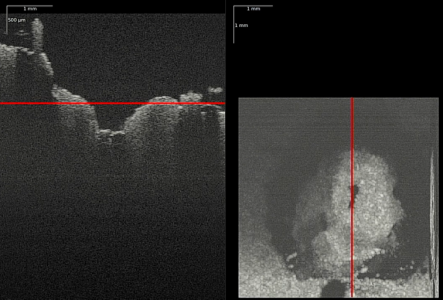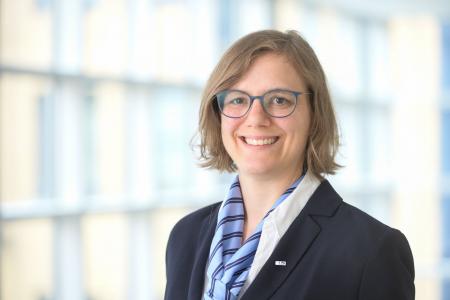Spinal canal stenosis refers to the narrowing of the vertebral canal, a condition that occurs frequently due to age and is capable of causing severe pain. Surgical intervention is a common treatment for such cases. Researchers in the InTherSteLa project are exploring ways to make these surgeries easier for both doctors and patients.
Laser Instead of Milling – Enhanced Precision with OCT
They intend to develop a handheld device equipped with a laser and optical monitoring capabilities for more precise bone removal. Traditionally, spinal canal stenosis surgeries involve expanding the vertebral canal using a milling tool: Part of the posterior bony arch of a vertebra as well as parts of the intervertebral joints are thinned out and finally broken through. There is always a risk that the underlying meninges surrounding the nerve canal may be injured and cerebrospinal fluid may leak out. Such complications not only prolong the surgery itself but also the recovery time for patients.

Optical Coherence Tomography (OCT) can depict deeper tissue structures, allowing surgeons visual process control. (Photo: LZH)
To prevent such injuries, researchers aim to provide surgeons with visual process control. Optical Coherence Tomography (OCT) enables the visualization of tissue layers beneath the bone. Surgeons can thus determine how much bone they can remove without hitting the meninges. The laser allows for precise bone removal with an accuracy of 10-100 μm, making it an excellent tool for creating a precise passage to the nerve canal. A combination of milling and laser removal would be possible with this therapy.

Full Control with a Flexible Handpiece
In addition to optimizing laser parameters for bone removal and visual representation, LZH researchers are primarily focused on making future therapy practical. A handpiece, similar to an endoscope, should enable surgeons to adapt flexibly to the circumstances during surgery. The requirements for such a handheld device are being developed in collaboration with an experienced surgeon and are to undergo preclinical testing.

About InTherSteLa
The InTherSteLa project (Innovative Therapy for Spinal Canal Stenosis using Laser Ablation under OCT Control) is coordinated by the Research Association for Precision Mechanics, Optics, and Medical Technology (FOM) and funded by the Federal Ministry for Economic Affairs and Climate Action (FKZ: 22642 N).
The project's industry advisory committee includes Asklepios Kliniken Hamburg GmbH, FiberBridge Photonics GmbH, Laseroptik GmbH, LISA Laser Products GmbH (OmniGuide Holdings), OCTLIGHT ApS, Pantec Biosolutions AG, Qioptiq Photonics GmbH & Co. KG, Quazar Software GmbH, RIWOspine GmbH, Sill Optics GmbH, the SPECTARIS Association, and TEM Messtechnik GmbH.
Laser Zentrum Hannover e.V. (LZH)
As an independent, non-profit research institute, the Laser Zentrum Hannover e.V. (LZH) stands for innovative research, development, and consulting. Supported by the Lower Saxony Ministry of Economics, Transport, Construction and Digitalization, the LZH is dedicated to selflessly promoting applied research in the field of photonics and laser technology. Founded in 1986, almost 200 employees are now working at the LZH.
The LZH offers solutions to current and future challenges with its smart photonics. Along the process chain, natural scientists and engineers work interdisciplinary together: from component development for specific laser systems or for quantum technologies to process developments for a wide variety of laser applications, for example for medical and agricultural technology or lightweight construction in the automotive sector. 19 successful spin-offs have emerged from the LZH to date. Thus, the LZH creates a strong transfer between fundamental science, application-oriented research, and industry - and uses light for innovation.


